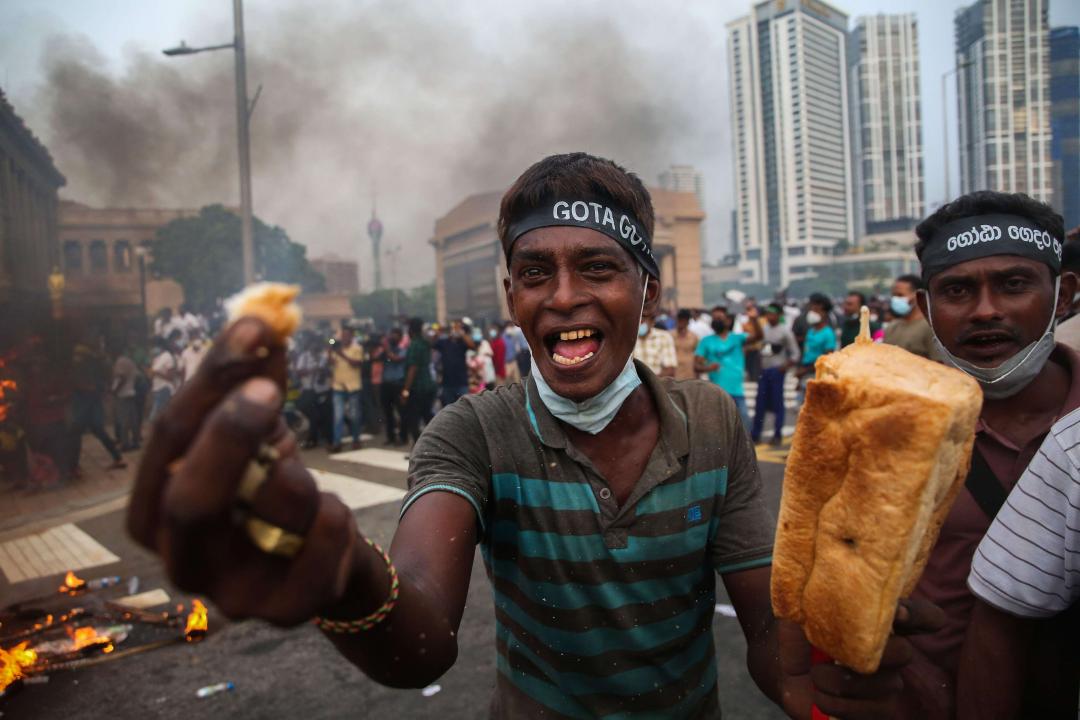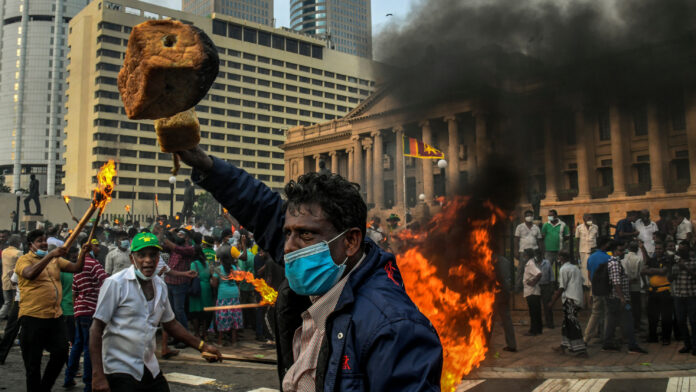Protest movements in Sri Lanka have historically taken place in bursts and have been shaped by crises. At critical moments the people have thrown out authoritarian or otherwise unpopular regimes, ensured the survival of democracy and even changed the economic trajectory. The Great Hartal of August 1953 was one such moment. It will be for historians to decide if the hartal of 6 May 2022 and the uprising on 9 May to defend the current protests are also of such historical significance.
The question now is whether the ongoing protests can be sustained during what is widely considered Sri Lanka’s worst economic crisis since independence. People have come out in force to demand the resignation of President Gotabaya Rajapaksa. But there are many currents within the movement that represent the broad spectrum of working people’s politics.
To analyse this resistance, we must start by understanding what has triggered it. In an immediate sense, people are responding to severe political malpractice and economic mismanagement by the Rajapaksa government. The government ignored the economic crisis in the aftermath of the Covid-19 pandemic that had been caused by the collapse in tourism revenues and the decline of migrant remittances. Although the country could no longer roll over sovereign debt accumulated over a decade and a half (constituting around 40% of its total external debt), the regime argued that it could avoid default and wade through the crisis.
The government hoped tourism and remittances would recover. It relied on a strategy of short-term bilateral swap agreements to boost the falling foreign reserves. However, the crisis came to a head in March of this year as it became clear that Sri Lanka had essentially run out of foreign exchange to pay for imports and to service debt. As a result, the country started experiencing extreme shortages of food, fuel, and other critical imports.
People who had been experiencing economic difficulties with the onset of the pandemic, began protesting across the country in a more militant way against the skyrocketing prices of goods—including the doubling of the price of petrol, rice and bread—and the emergence of long queues due to the shortage of supplies, in which several people died while standing in the scorching heat. Dissent began to converge when, on the night of 31 March, hundreds of protestors swarmed and attempted to enter President Rajapaksa’s house in Mirihana, a suburb of Colombo. Subsequently, protestors began gathering in various parts of the country, most visibly at the seaside location of Galle Face Greene, in the heart of Colombo.
“The gathering momentum of working people’s protests over the past year represents a watershed in the history of the country. How will the protest movement go forward?”
The protestors demanded the ouster of both the president and his brother, Prime Minister Mahinda Rajapaksa. Eventually, hundreds of trade unions entered the fray. A massive countrywide hartal was called for 6 May. In response, the regime declared an emergency law the next day. Finally, on 9 May, Mahinda Rajapaksa sent mobs to attack protestors at Galle Face, leading to a countrywide explosion of violence and reprisals, including the torching of houses owned by ruling-party members of parliament.
Mahinda Rajapaksa resigned the same day, but in a dramatic move, Ranil Wickremesinghe, a former prime minister and ostensibly an opposition member of parliament, was sworn in as prime minister. He promised to restore essential supplies with a possible infusion of cash from the US and its regional allies, such as India and Japan.
The protest movement demanding Gotabaya’s resignation now stands at the crossroads. The question of why these external actors rushed in to rescue the Rajapaksa regime is linked to the way in which ruling elites themselves began to be targeted by the protestors on 9 May. There existed the possibility that events could turn into a countrywide unrest of revolutionary proportions not seen since the hartal of 1953.
“Every so often Sri Lanka becomes a symbol of wider changes happening in the world. It appears to recall earlier tendencies and anticipate new ones”
The fact that homes and vehicles of the ruling party politicians were destroyed is a sign of the broader social collapse in the legitimacy of the ruling class. The question now is whether restoring essential supplies will be enough to placate the protestors who have gathered far and wide. The gathering momentum of working people’s protests over the past year represents a watershed in the history of the country. How will the protest movement go forward? To answer this question, it helps to examine Sri Lanka’s past, and the indigenous vocabulary of resistance that has developed over time.

Food riots, the IMF, and international solutions
Every so often Sri Lanka becomes a symbol of wider changes happening in the world. It appears to recall earlier tendencies and anticipate new ones. As Walton and Seddon (1994) put it in their well-known collection analysing food riots triggered by the structural adjustment policies of the International Monetary Fund (IMF), the hartal of 1953 in Sri Lanka was the first and, in a way, a unique protest of its kind until the debt crises of the early 1980s that affected developing countries. Now, the island is once again witnessing a hartal that has rekindled interest in these aspects of its history. But the question is whether it also prefigures global changes, especially considering the debt crunch affecting countries across the Global South in the aftermath of the Covid-19 pandemic.
Much of the media portrayal of the current protests has focused on the middle-class background of the protestors. It has highlighted the ways in which the ongoing economic crisis has affected even those who were generally considered better off. But as the hartal on 6 May and the government’s frightened reaction in the form of imposing a state of emergency demonstrate, the real threat to the ruling elite is the fact that the current protest movement represents the formidable power of working people’s protests.
“For the masses of people in Sri Lanka undergoing severe economic hardship today, their identification of the causes of the crisis may vary”
Colvin R De Silva, one of Sri Lanka’s socialist leaders, argued in his pamphlet Hartal!, published in 1953, that the tactic of the hartal is a wider weapon than a general strike. It includes not only the working class but also the urban poor and rural communities. To talk about a hartal requires interpreting working people’s politics as a diverse and at-times contradictory relationship. For the masses of people in Sri Lanka undergoing severe economic hardship today, their identification of the causes of the crisis may vary. For example, farmers may demand a higher price for rice, while consumers demand that prices be subsidised to contain the effect of rising costs. Despite these apparently diverging attitudes, however, there is the possibility of viewing the current protests from the perspective of food sovereignty, which could bring the different concerns together by anticipating the creation of an alternative order.
“The protest movement did not emerge out of thin air but consists of an array of actors losing all hope in the state and its capacity to relieve their day-to-day suffering”
In recent days, the manoeuvrings of global actors have created space for the comprador elites of Sri Lanka to reassert themselves and attempt a temporary stabilisation programme. Much of this strategy relies on dividing the resistance movement. But the fact that the protest movement is much wider in regional and class terms than the protests at the now famous GotaGoGama site in the heart of Colombo, mean that it cannot simply be glossed over by looking to the IMF for a solution. Instead, the protest movement represents the political consequences of the breakdown of the market, and the implicit, if not explicit, demand for a new social contract that can resolve the underlying challenges.
It is also critical to keep in mind that the protest movement did not emerge out of thin air. It consists of an array of actors who have lost all hope in the state and its capacity to relieve their day-to-day suffering. It helps to start by comparing pivotal historical moments in the electoral defeat of authoritarian or otherwise unpopular regimes in Sri Lanka, and what these imply for understanding the resilience and potential trajectory of the current movement.
Hartal of 1953 and the crystallisation of popular consciousness
In the 1930s and 1940s, Sri Lanka developed a set of strong welfare mechanisms, especially healthcare, education, and the food subsidy, in response to the implicit and explicit pressures of working people’s politics. These occurred against the background of the Great Depression and the Second World War. The post-Independence government, however, confronted challenges because the country remained dependent on primary exports for foreign exchange earnings. After the end of the Korean War rubber boom, the country experienced a fiscal crunch.
On the advice of the World Bank, the United National Party (UNP) government of the day, led by Dudley Senanayake, announced in August 1953, that the price of rice would increase to 70 cents a measure from 25 cents. On 12 August 1953, the burgeoning left forces represented primarily by the Trotskyist Lanka Sama Samaja Party (or LSSP, of which Colvin R De Silva was a member) and other smaller left parties, called for a hartal. People flooded onto the streets. After 12 protestors were killed and many more injured, the government rescinded the cuts. For decades after, no government would seriously attempt to curtail the food subsidy.
“The hartal of 1953 in Sri Lanka raised issues about the meaning of democratic sovereignty”
The hartal itself was an innovation in the context of Sri Lanka’s resistance movements, but it drew from a longer tradition in South Asia. As De Silva pointed out, the idea emerged from its successful employment against the British during the Quit India movement initiated in August 1942. In response to the longue durée of economic shocks that colonialism imposed on India—as Mike Davis, for example, has analysed in his book, Late Victorian Holocausts, by locating the cause of famines in an early form of market fundamentalism applied to colonies around the world—the hartal became a general form of resistance to the forces of dispossession.
A further evolution of this trend, the Great Hartal of 1953 in Sri Lanka raised issues about the meaning of democratic sovereignty, insofar as the protest was directed against an ostensibly independent national regime. Nevertheless, the UNP was characterised as comprador and very much beholden to neo-colonial powers. The hartal dovetailed into a longer political struggle to achieve “real independence” by the LSSP and other, smaller left parties. The prime beneficiary of this political shift, however, ended up being the Sri Lanka Freedom Party (SLFP), which won the elections of 1956.
The political shift in 1956 articulated the complex issues exposed by the hartal of 1953 as a question of dethroning a culturally deracinated westernised elite and at the same time furthering the agenda of Sinhala Buddhist majoritarian mobilisation. In this way, the politics of nationalism began to overtake the class politics of the anti-colonial left, eventually subordinating the left to its own ends. The ‘Sinhala Only’ policies of 1956 provoked an ethnic conflict, primarily between a majoritarian Sinhala polity and emerging Tamil nationalism. Furthermore, the economic discontent of the rural youth led to the first Janatha Vimukthi Peramuna (JVP) insurrection of 1971, which was an eclectic movement of youth inspired by Mao and Che Guevara that tried to overthrow the state. These developments paved the way for future regimes to consolidate authoritarian power, especially the regime of JR Jayewardene in 1977.
The failed general strike of July 1980 and new resistance
Another turning point in Sri Lanka’s resistance movement was the crushing of a general strike in July 1980 by the JR Jayewardene regime. The left forces, including the LSSP and Communist Party, which had previously come to power in 1970, had been “inescapably delegitimised” by the difficulties brought about by the global economic downturn of the 1970s (Herring 1987). They had been further compromised by participation in the bloody suppression of the JVP in 1971.
In the decisive parliamentary elections of 1977, the Jayewardene regime was able to convince the electorate that it could offer prosperity. A year later, it centralised powers further by creating the office of the executive presidency. Its agenda was to consolidate authoritarian power to ram through neoliberal changes—such as floating the exchange rate, slashing import tariffs, cutting the food subsidy, and generally pursuing trade and financial liberalisation—with the support of dominant global institutions such as the IMF and World Bank. The failure of the general strike of 1980 was the result both of divisions within a still-reeling left movement, and the Jayewardene regime’s ruthlessness in combining legal and extra-legal tactics to conduct an all-out assault on organised labour.
“[T]he ethnic conflict became the rationale for state intervention in the economy, including a major boost in military expenditure”
However, the process of economic liberalisation continued to engender economic tensions that would produce contradictory political responses, insofar as nationalism became a complex ideological mirror for class issues (Shastri 1997). Above all, the ethnic conflict became the rationale for state intervention in the economy, including a major boost in military expenditure, despite the IMF and World Bank’s overall emphasis on deficit reduction. Within the polarising context of the war, politics in the South also continued to reflect class issues that were refracted, however, through other debates.
The Second JVP insurrection of 1987-89, much like the First Insurrection of 1971, provoked the government at the time to consider other responses to popular needs. That government, led by Jayewardene’s successor, Ranasinghe Premadasa, combined a ruthless strategy of counterinsurgency with the establishment of a new system of social security, including the cash transfer mechanisms of the Janasaviya Programme and the midday meal for schoolchildren. These efforts to try and restore some degree of food security reflected the continuing need to contain the most dramatic effects of liberalisation on vulnerable and marginalised communities.
The legacy of welfarism shaped subsequent regimes, which tried to balance the demands of powerful global institutions and comprador elites with the need to maintain political legitimacy in Southern Sri Lanka, to sustain military efforts to subordinate the North and East, where the civil war between the government and Tamil separatists was primarily fought. Even the seemingly all-powerful government of Mahinda Rajapaksa encountered resistance when, after a pyrrhic victory against the Tamil Tigers in 2009, it attempted to implement neoliberal policies, such as raising fuel prices, undermining pensions, and reducing the budget for education and other services.
“The elite’s approach to the current crisis focused first on an IMF agreement towards macroeconomic stabilisation”
The people responded with protests in 2011 in the Katunayake Export Processing Zone (EPZ), by the fishing community of Negombo in 2012, the strike of university teachers that same year, and the tacit resistance to militarisation and dispossession of land in the North. These streams of resistance converged, paving the way for the electoral defeat of the Rajapaksa regime in 2015. In this regard, there remains the possibility that in the context of the current protest movement, trade unions could again play a significant role, despite their weakened state given their long decline since the defeat of July 1980. But that requires staying vigilant of the tactical moves of the beleaguered regime of Gotabaya Rajapaksa and the over-determination of the political crisis by powerful external actors. The immediate support extended by the US and several major powers to the installation of Prime Minister Ranil Wickremesinghe, who faced a thumping defeat in in the last parliamentary elections, is an example of the over-determination of the economic crisis by imperial intervention.
The acute crisis in Sri Lanka occurs against the background of an ongoing global economic downturn, which is having a severe impact on import-dependent countries in the South. Indeed, questions are emerging about alternatives to the global neoliberal order that is now under considerable strain.
The Sri Lankan elite’s approach to the current crisis focused first on an IMF agreement towards macroeconomic stabilisation. And when pressure mounted with calls for Gotabaya’s resignation, they have sought ways of establishing a constitutional interim arrangement before elections can be held under conditions of normalcy. The basic contours of the economic strategy include raising energy prices, retrenching the state sector, and privatising public assets. However, the protests represent the political consequences of the collapse of the market and their convergence with democratic demands such as abolishing the executive presidency.
The moment also provides possibilities of addressing grievances of minority communities under attack by the Sinhala Buddhist nationalist project, which was a hallmark of the Rajapaksas. While much of the Tamil nationalist elite have been calling on the war-torn Northern people to avoid joining the protest movement, worried perhaps that their narrow nationalist politics may get diluted, the youth and working people are gravitating towards the historic protests as their economic hardship mounts. The messaging and activities at the protest sites, from the Muslim breaking fasts to the display of Tamil slogans, are hopeful signs of the interpenetration of demands across the North and South. The possibility exists for class and ethnic issues to merge and be taken forward through struggle.
Recurring struggles against dispossession
In addition to the immediate call for the resident to resign, among the multiple subcurrents of the resistance movement we can discern several essential features, including calls to control prices and distribute essential items. But as we have seen from the history of the hartal of 1953 and its effects on the reorganisation of state and agricultural production, there is no easy solution for achieving self-sufficiency that can create a new, sustainable system.
As the sociologist Ronald Herring pointed out, for example, while Sri Lanka dramatically improved self-sufficiency in rice to accommodate the need for a food subsidy, its efforts came at the cost of an increase in complex inputs such as fertiliser, which put pressure on the balance of payments (Herring 1994: 271). The disastrous decision of the current Rajapaksa regime to ban chemical fertiliser overnight reflects the contradictory legacy of agrarian relations, insofar as self-sufficiency in rice production came at the cost of more imported inputs such as fertiliser.
“The crisis in Sri Lanka and the protest movement that has risen in response, then, are both new and old”
The solution, however, is not as simple as following IMF recommendations. Instead, as agrarian scholars Raj Patel and Philip McMichael (2014) point out, rather than referring to protests such as the ones happening in Sri Lanka as “IMF riots,” we must uncover the logic of food sovereignty that provides an implicit outline of the solution to the protestors’ demands. Or as Patel and McMichael articulate, “the reaching for modes of politics that offer popular control over food policy and, indeed, the wider economy, are moments in which those disenfranchised by the food regime seek to become sovereign” (29).
Along the arc of history, the food riot reappears not because it represents a desire to return to a pre-capitalist past, but rather because of the ongoing pressures on people’s livelihoods, which undermine their capacity to even put food on the table. We must put the market back in its place. When the market becomes dis-embedded from society, as Karl Polanyi claimed, it generates recurring crises that not only undermine social reproduction, but also pose grave, existential dangers to society itself. That includes creating space for far right and fascist forces to take advantage of people’s suffering.
The crisis in Sri Lanka and the protest movement that has risen in response, then, are both new and old. The movement reveals a continuity with past protests across the Global North and South, from early struggles against rapacious industrialisation to contemporary riots triggered by debt crises and the IMF’s conditionalities for its financial bailouts. It also looks toward the future by calling into question our basic definition of the economy and the material basis on which political regimes operate.
Yet if we have not solved this question yet, it is not because the only way forward is to pursue liberalisation to a more extreme degree. Rather it is because we struggle to imagine what the alternative order would look like. To the extent there is hope, however, it lies in the fact that people in Sri Lanka will not quietly abandon their struggles. Instead, they will remain vigilant about the manoeuvrings of a beleaguered authoritarian regime with a decades-long neoliberal order, even if there are moves to rescue both with interventions by powerful hegemonic actors.
The working people’s resistance is likely to continue, if not in the current formidable manner then in bursts, as the long economic crisis continues. The question is whether there will be enough intellectual and political support to intervene in this moment, to deepen popular efforts to envision a new order in a way that does justice to the history and memory of the long struggle against the forces of dispossession.








